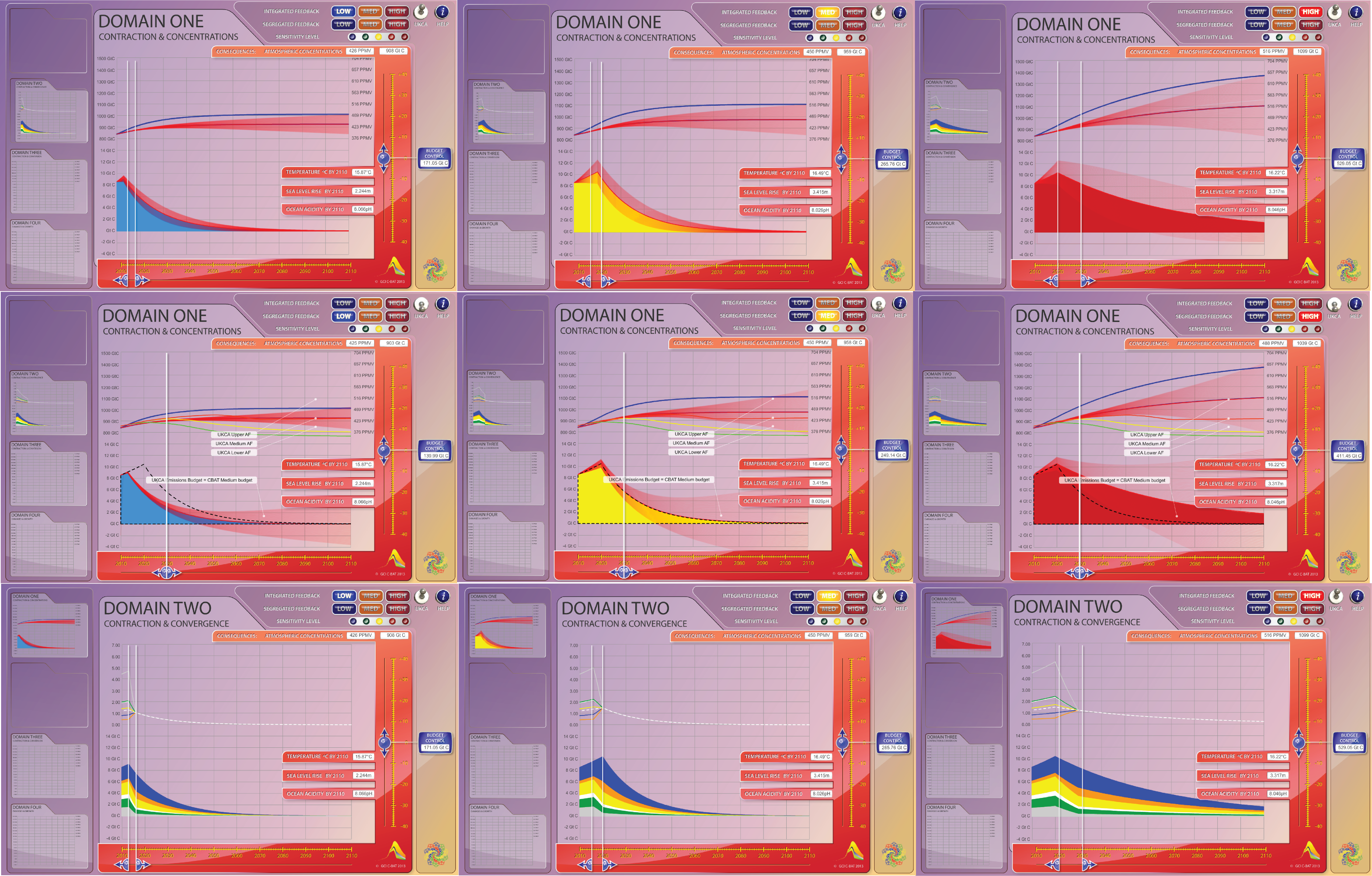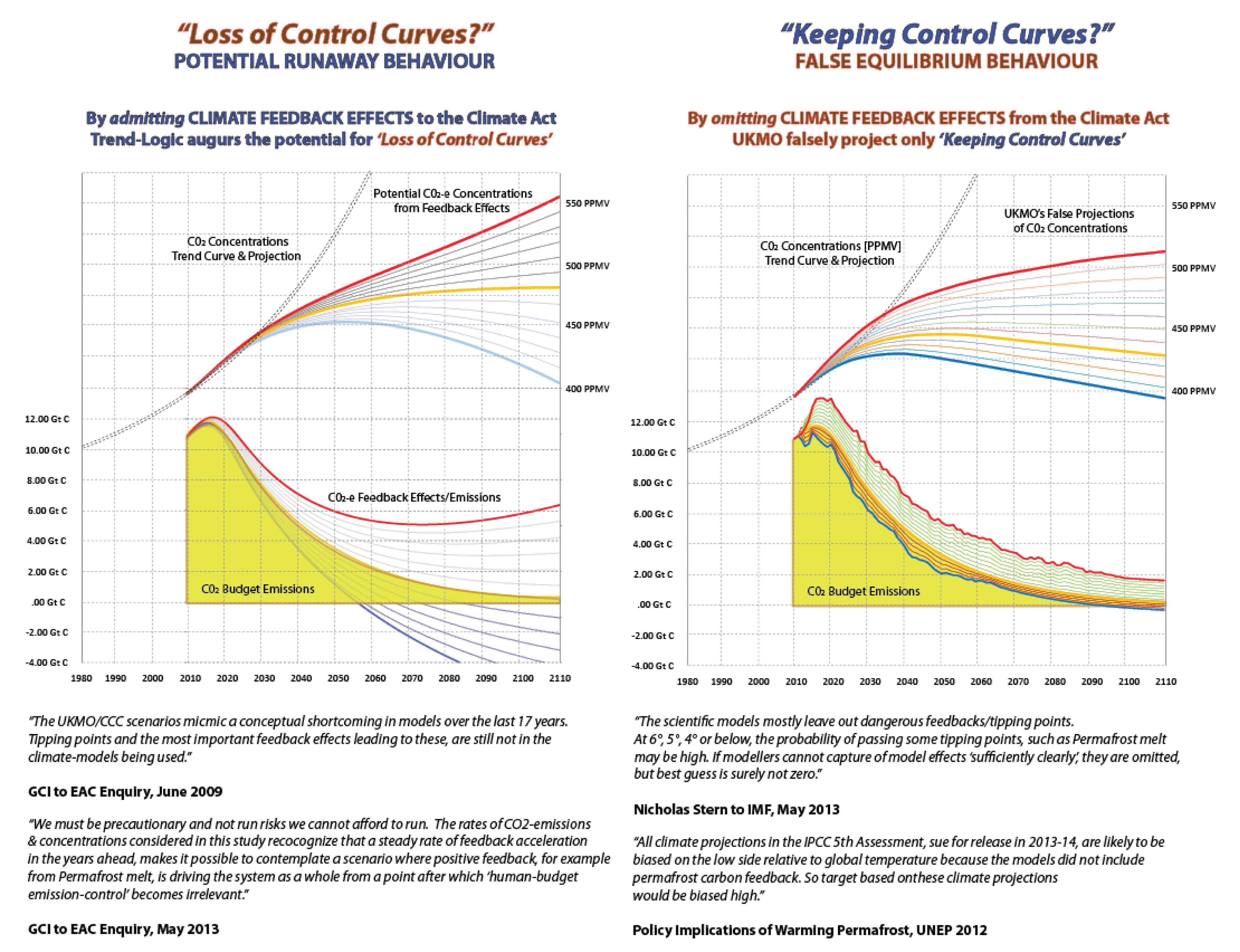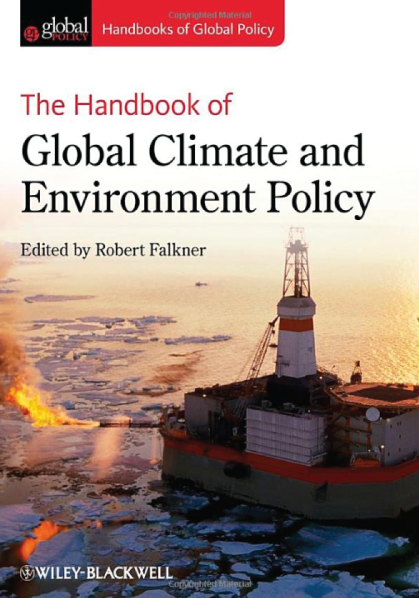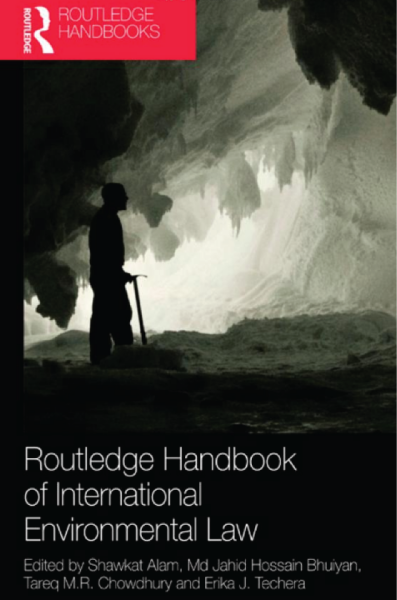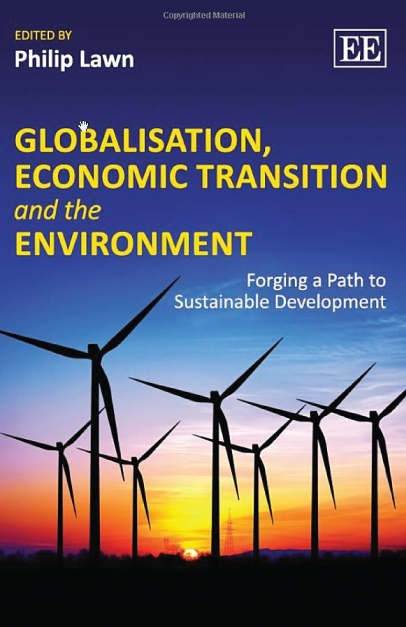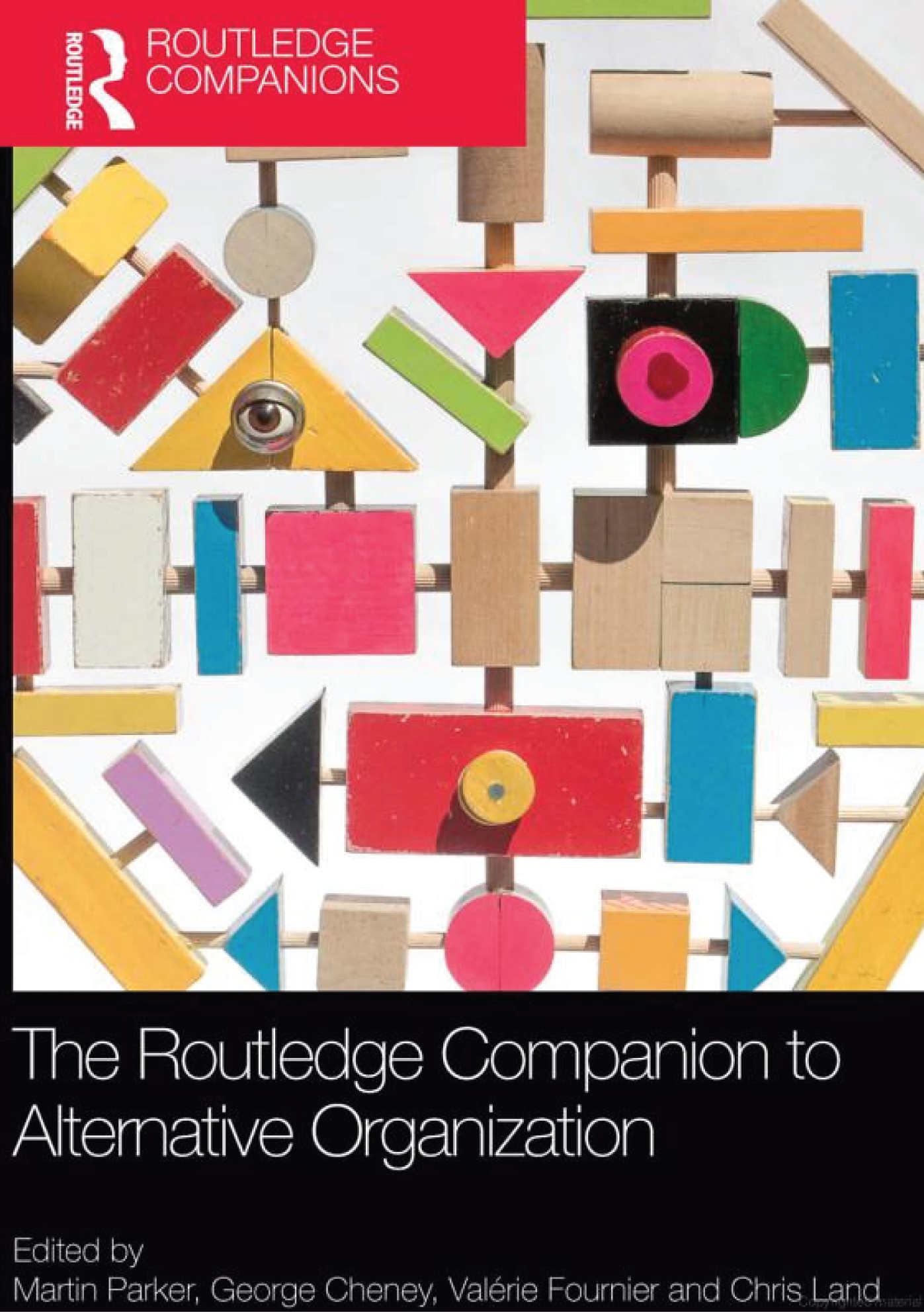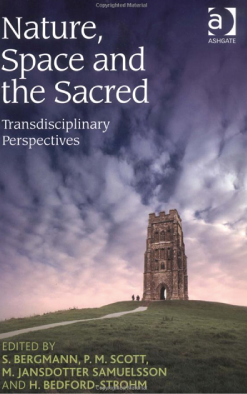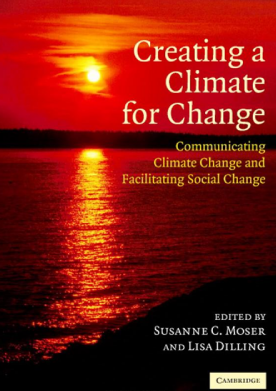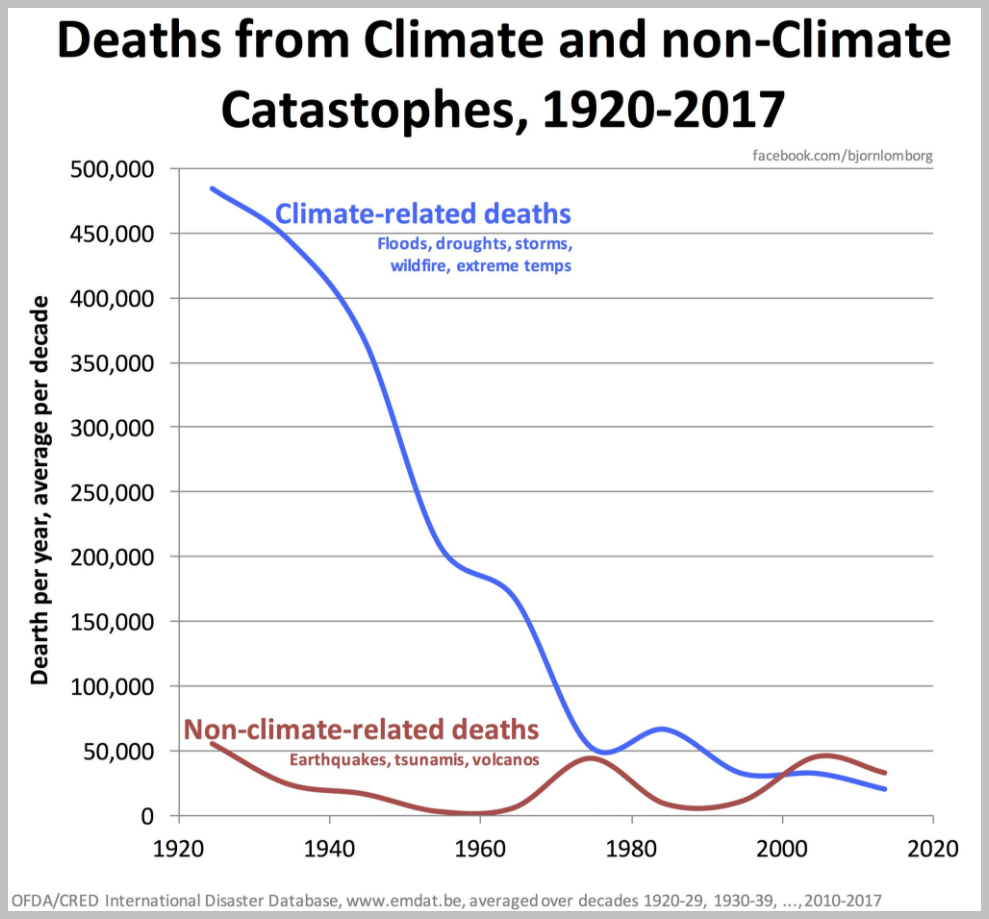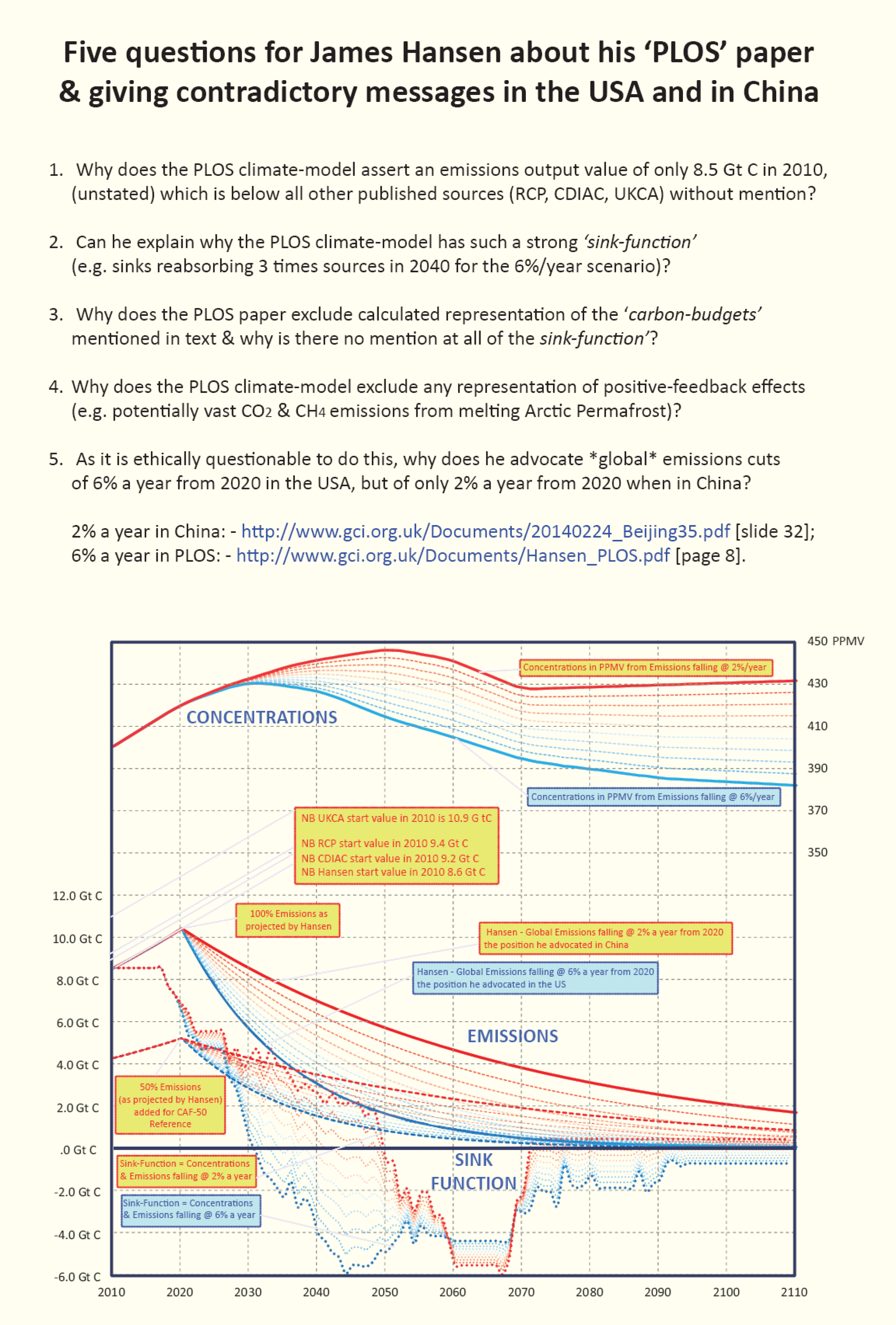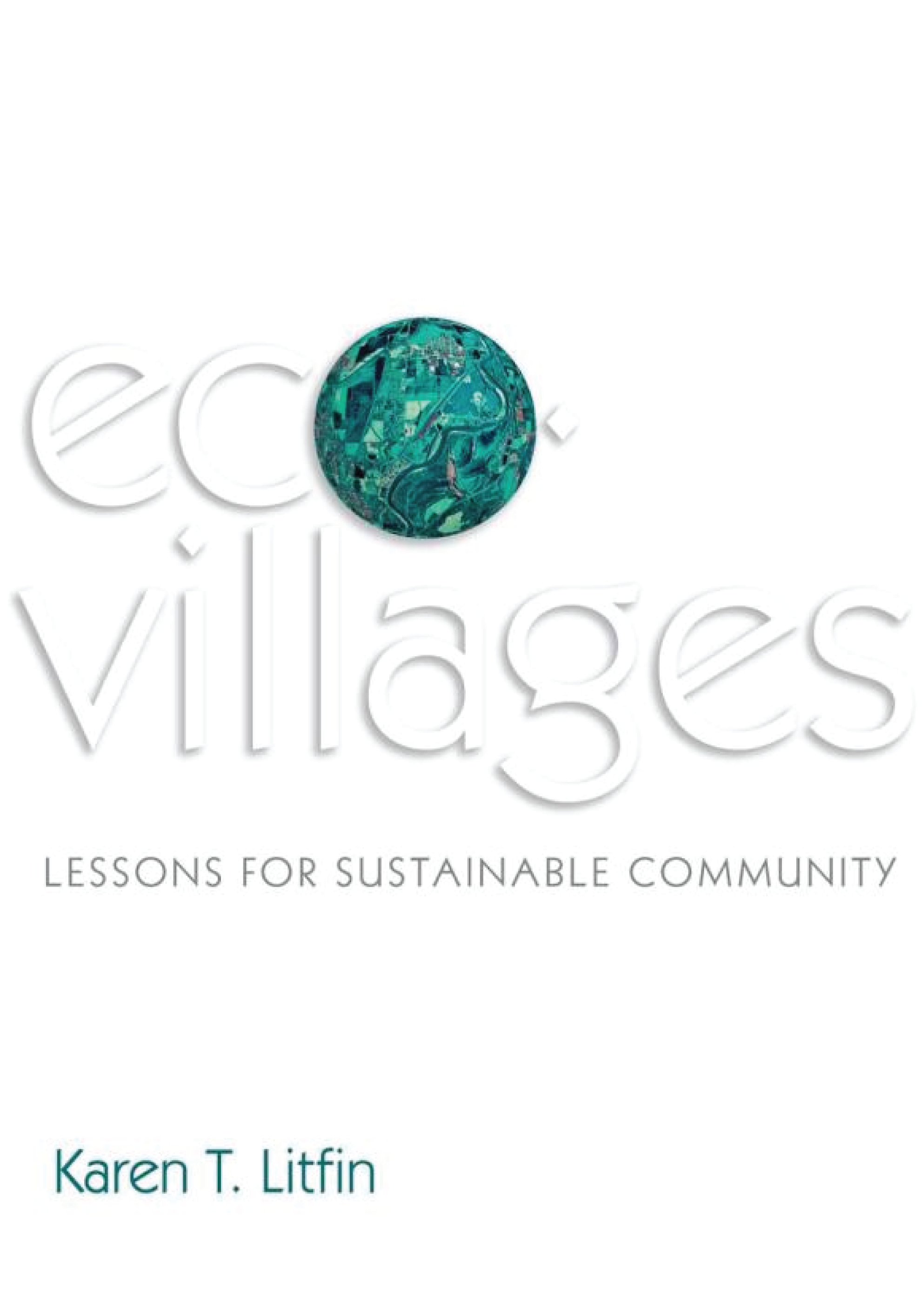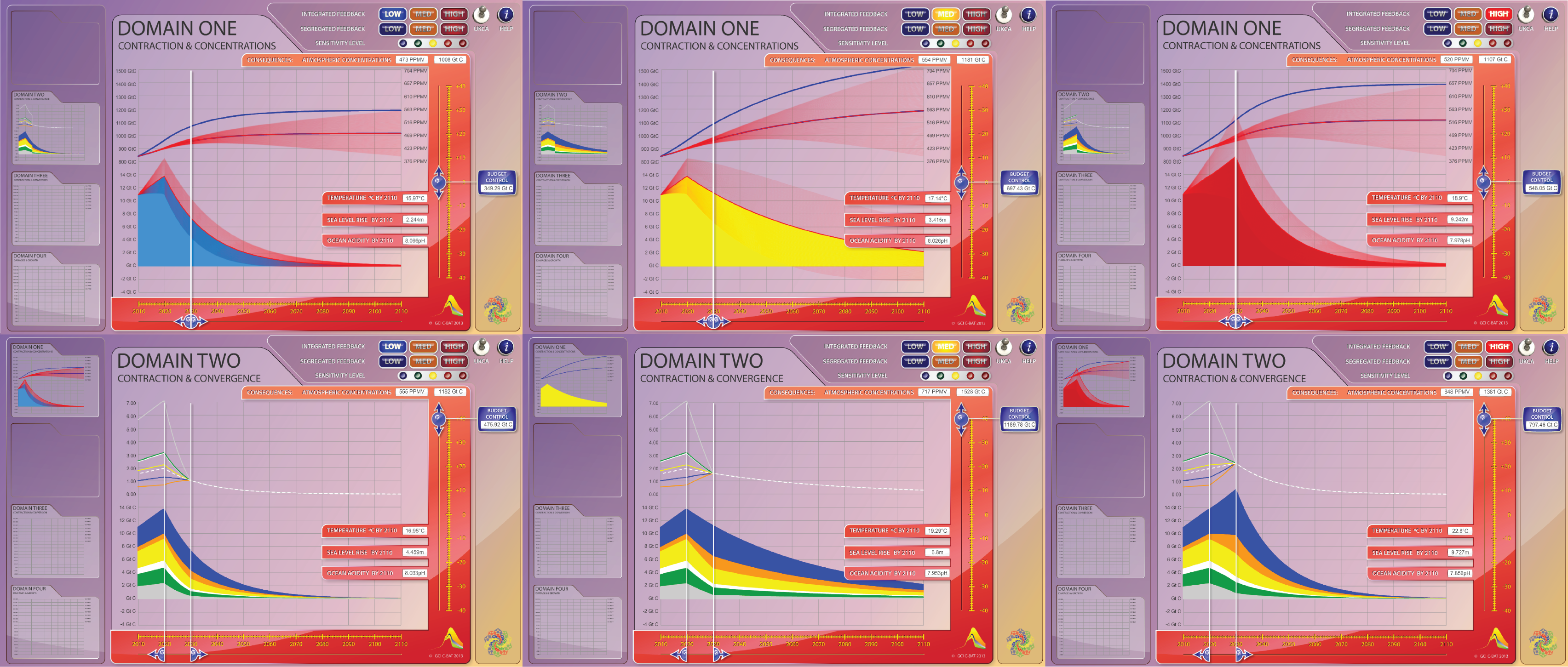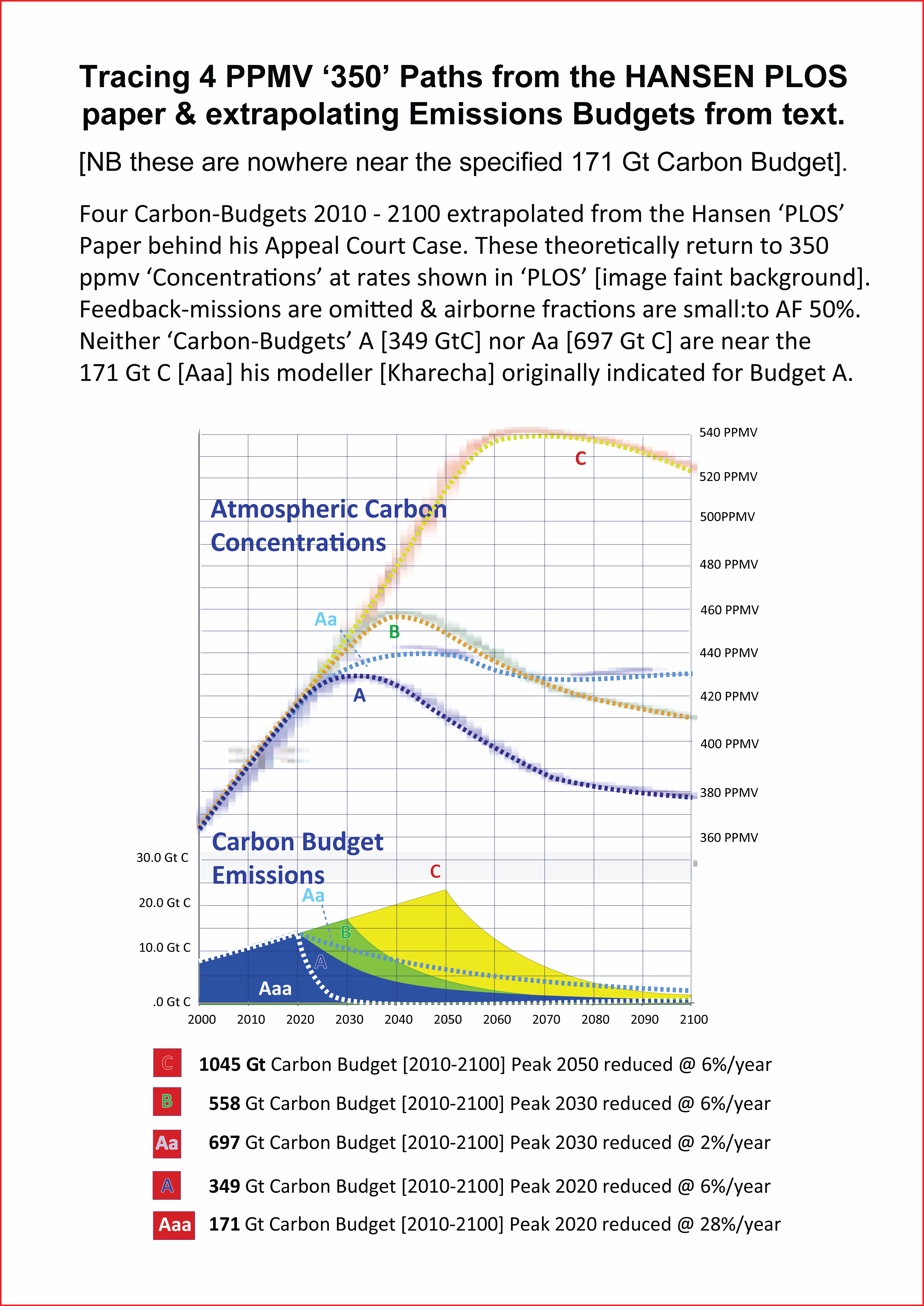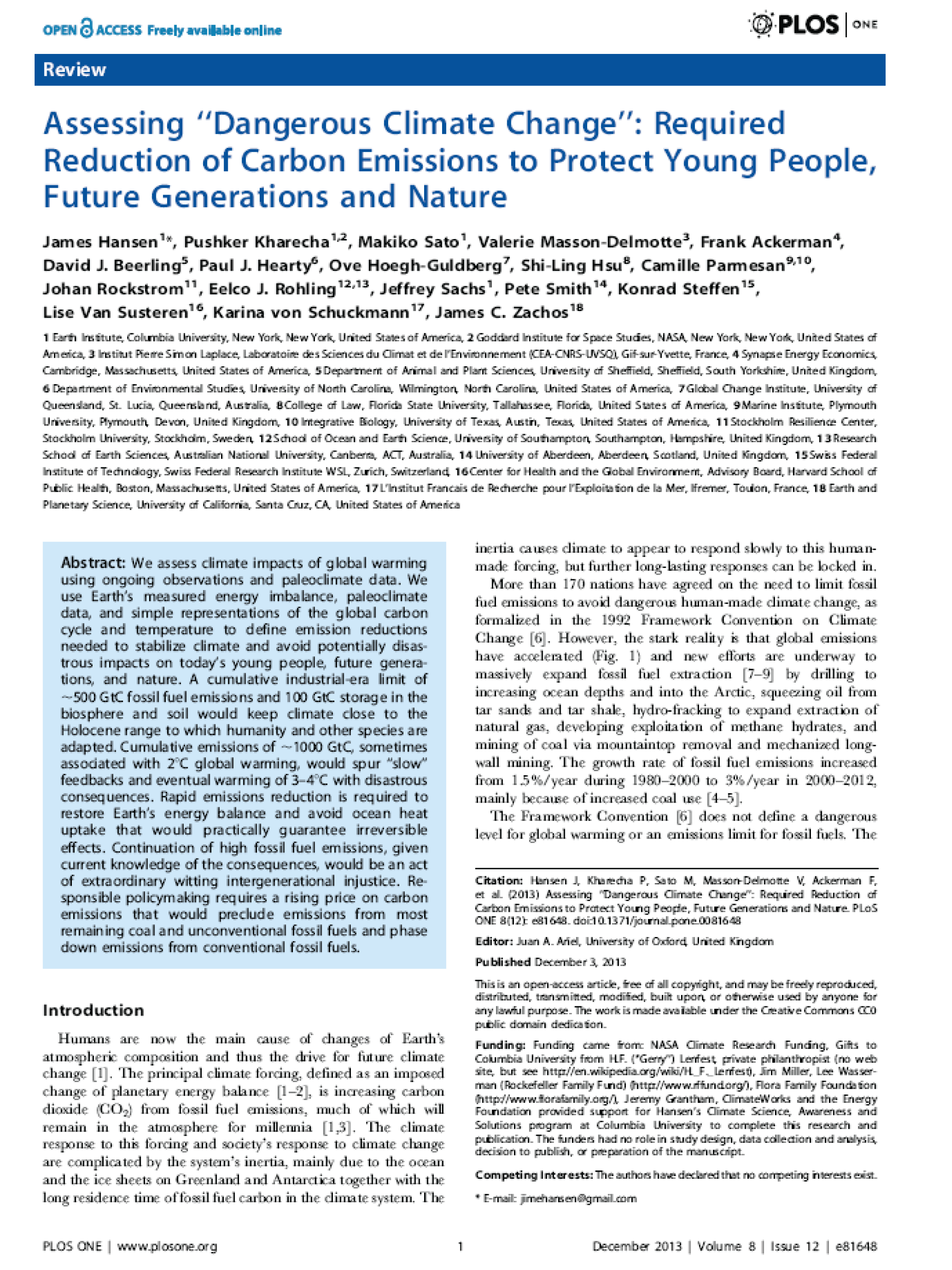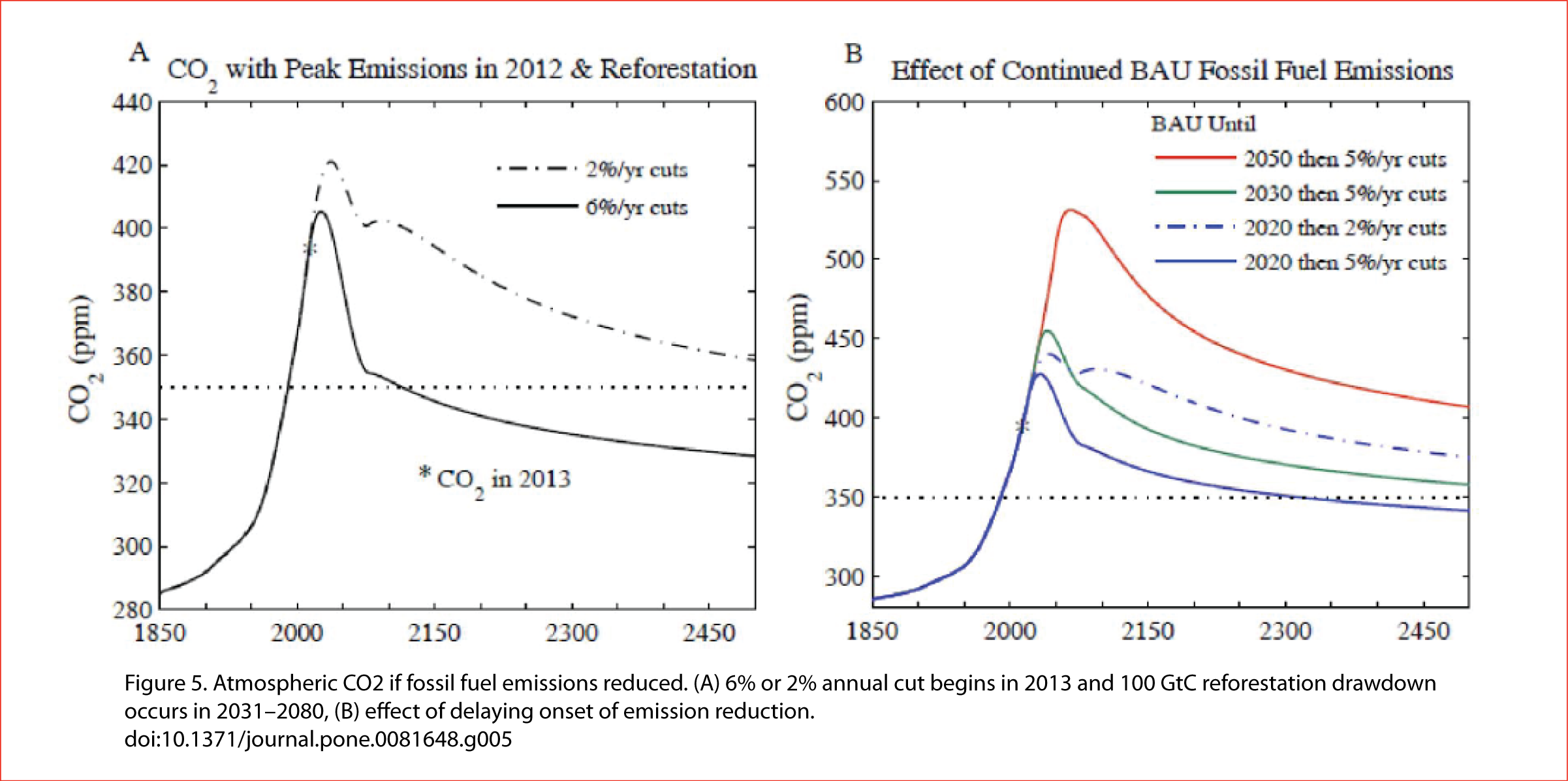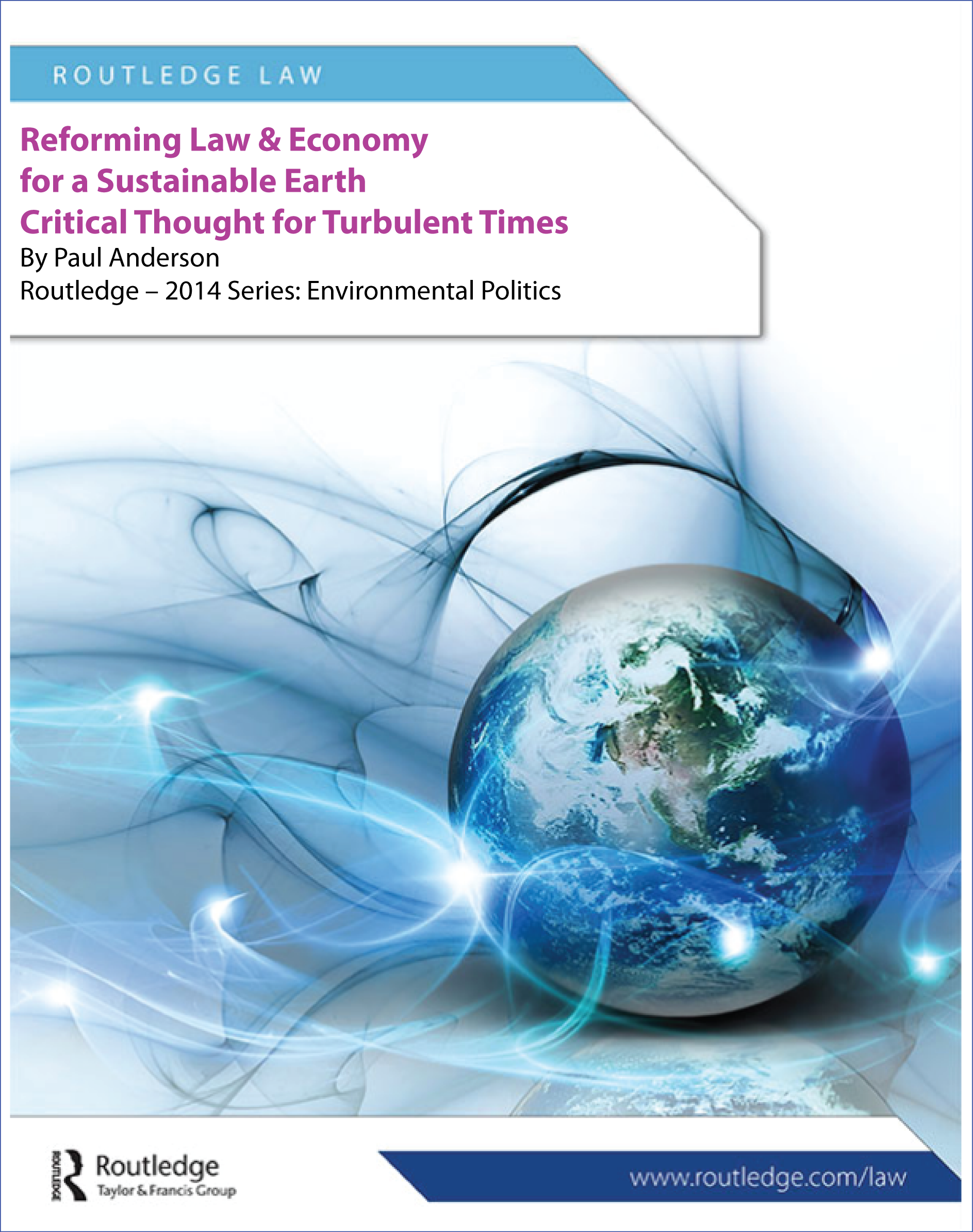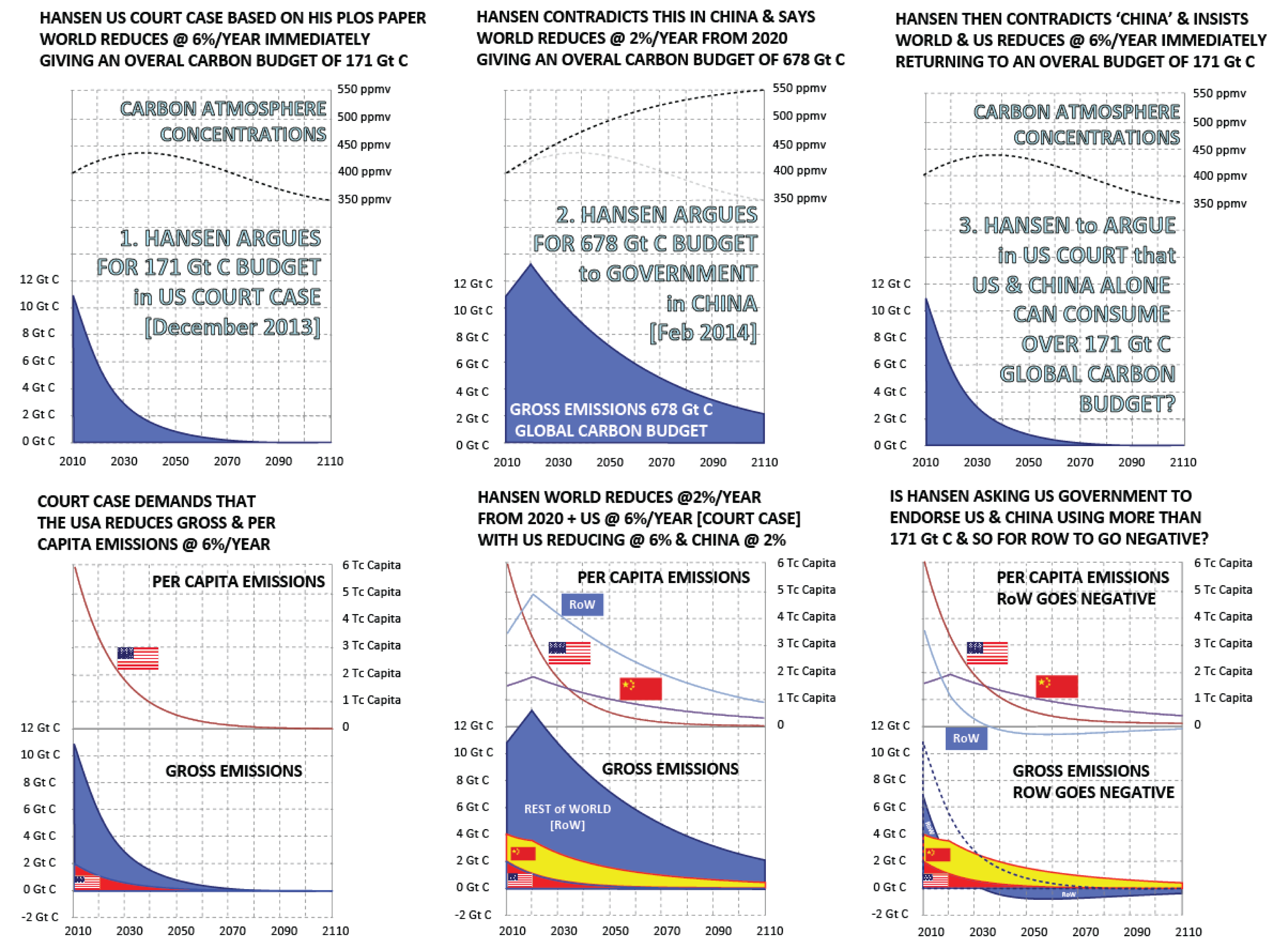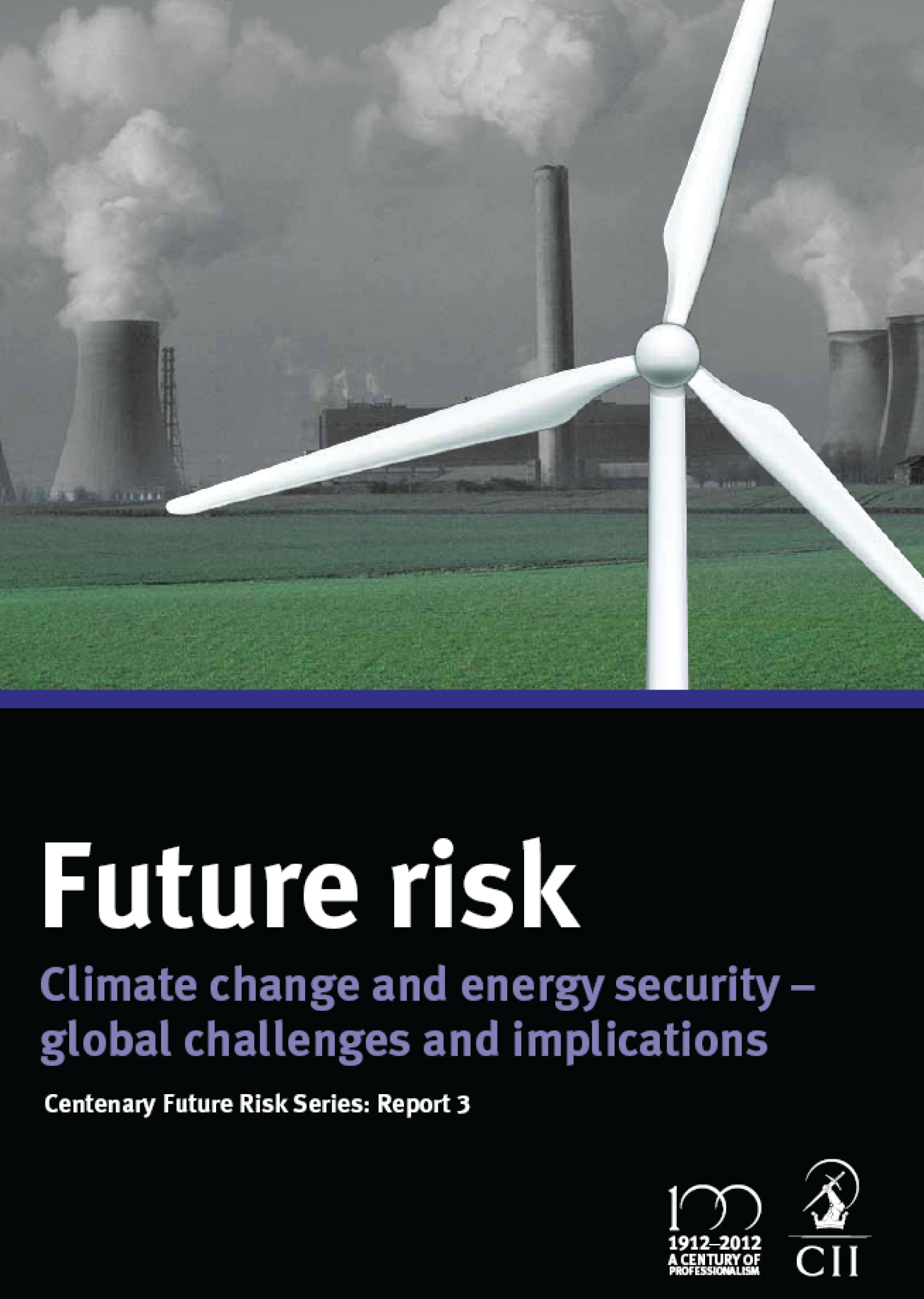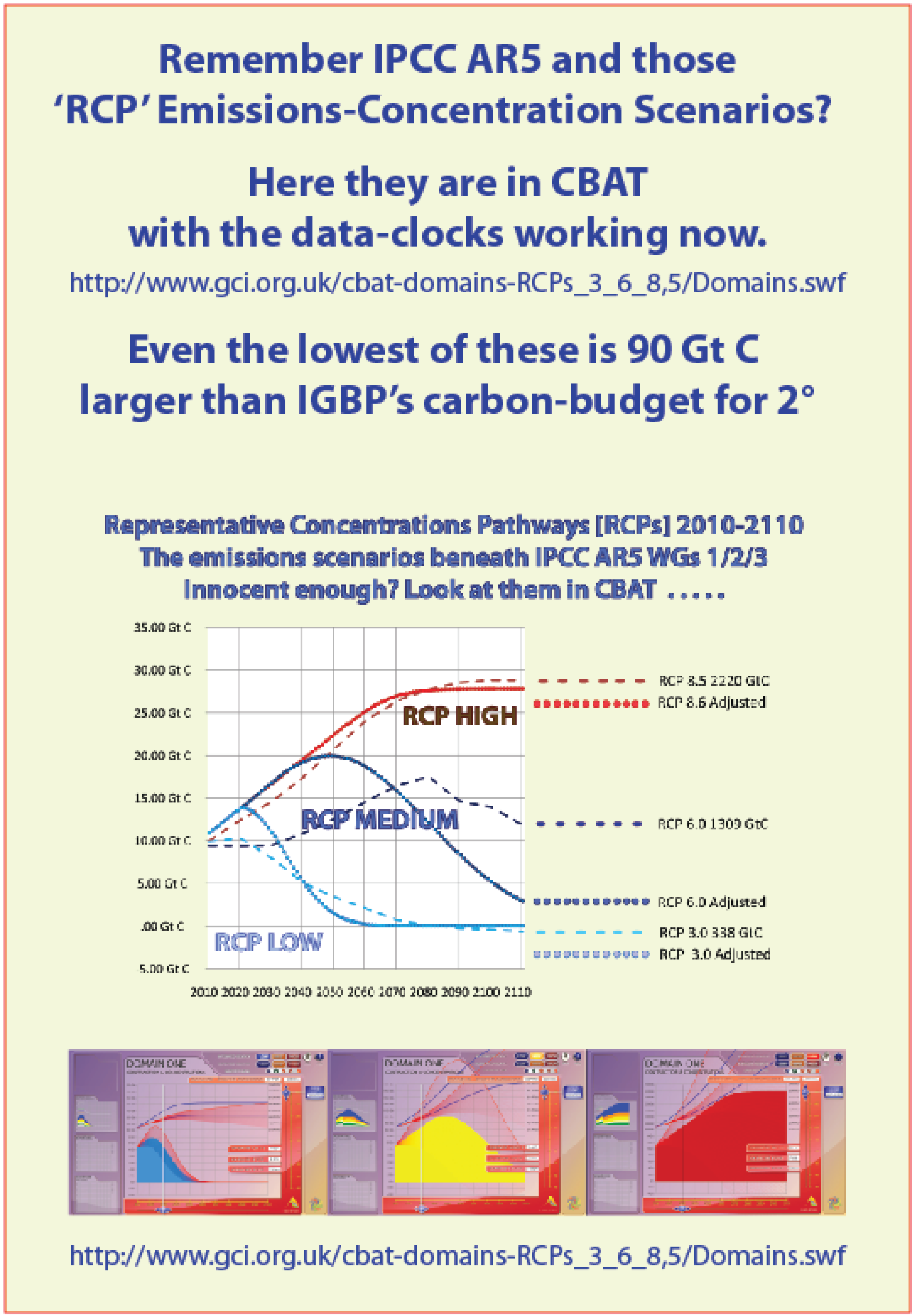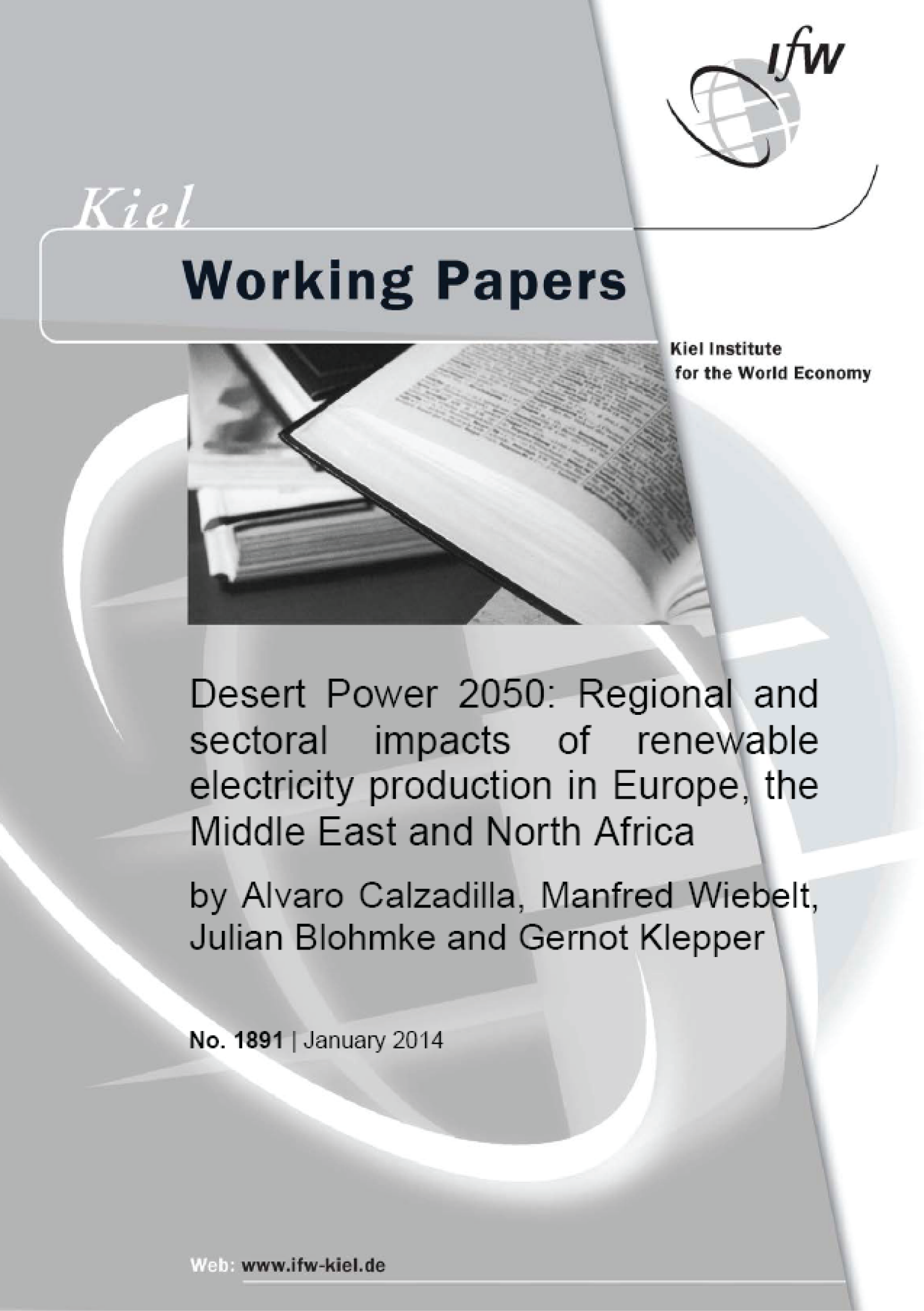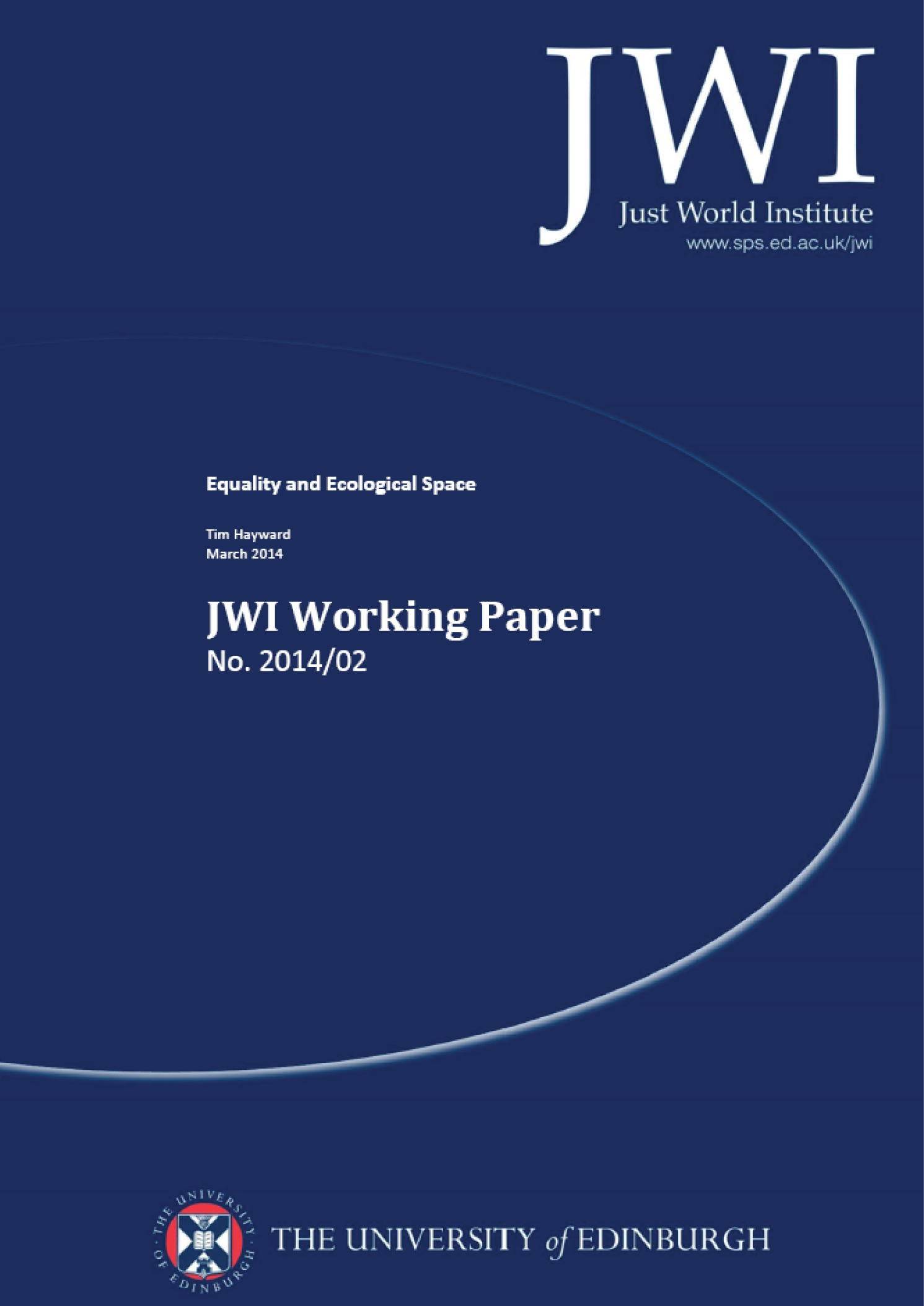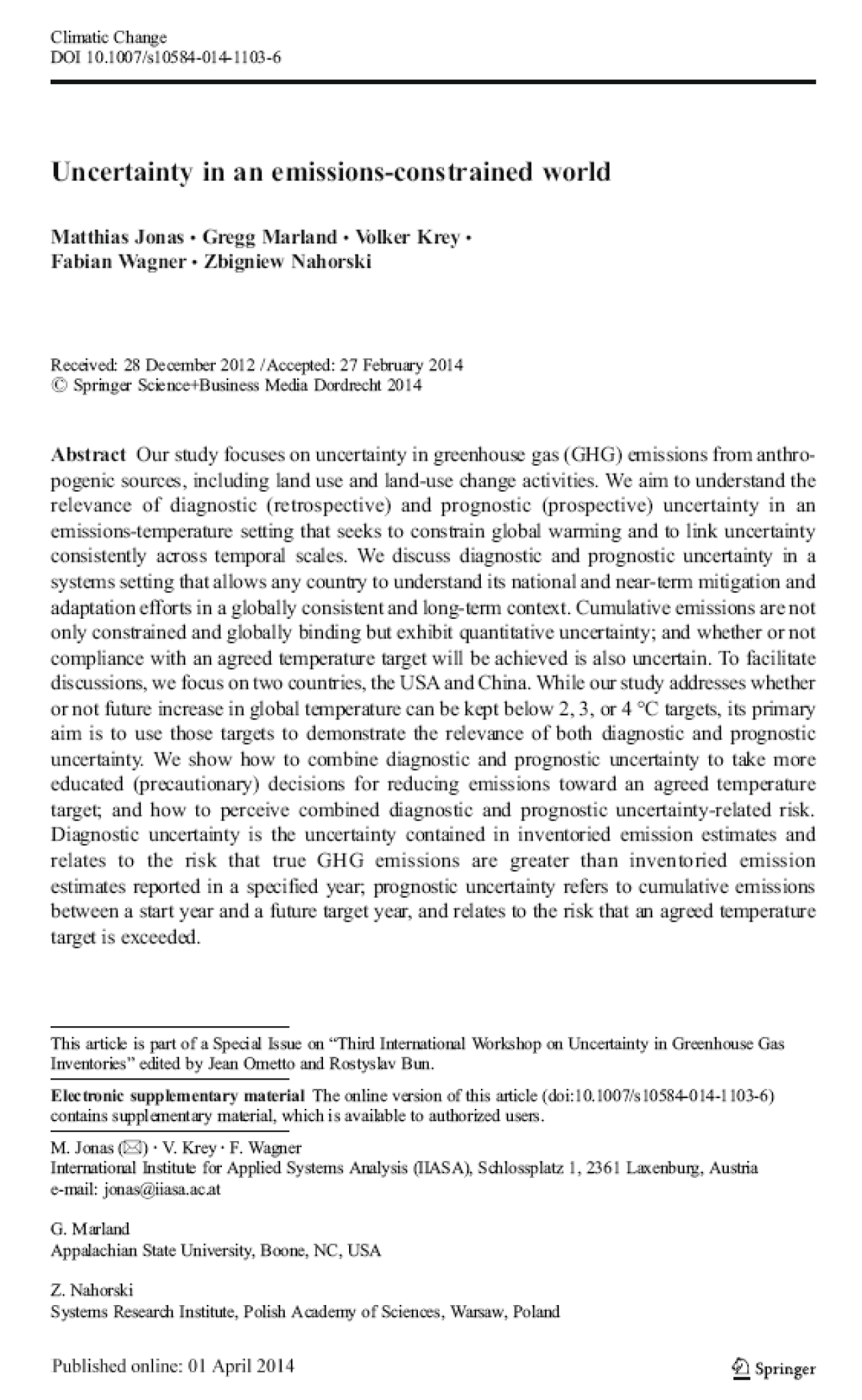 CBAT
CBAT NEWS
NEWS
CBAT clearly shows that James Hansen has omitted all positive feedback effects from his 'model'.
See CBAT animation of Hansen 171 Gt C [LOW]; Hansen 265 Gt C [MEDIUM]; Hansen 529 Gt C [HIGH] here.
It needs to be viewed carefully to see the enormity of this.CBAT shows all three of his concentrations curves when the UKCA switch is 'on' [one for LOW, one for MEDIUM & one for HIGH].
They are exactly the curves shown in his now disputed 'PLOS' paper. [Some detailed analysis here ].To 'see' these, switch the UKCA switch to 'ON' [ignore the indicator lines and labels; they will be removed] & choose 'Segregated Feedback' for LOW MEDIUM & HIGH. Then compare his atmospheric CO2 concentration curves with the in-built CBAT concentration curves [graduated above and below CAF 50] and using the vertical slider note the potential weight differences between the two.
His concentration line in: -
- GREEN corresponds to his 171 Gt C Budget [Choose CBAT LOW Budget Option].
- YELLOW corresponds to his 265 Gt C [Choose CBAT MEDIUM Budget Option].
- RED corresponds to his 529 Gt C Budget [Choose CBAT HIGH Budget Option].
The key thing is that when each of his Budget Curves is compared with each of his concentration curves, it show a truly massive deceleration [by anybody's standards and certainly by CBAT reference values].
This means Hansen assumes an unrealistically aggressive sink-function in his model as soon as emissions are theoretically cut. This means 'negative accumulation in the atmosphere' where the biosphere is literally sucking CO2 out of the air even as we continue to emit.
Compare that with the potentially huge acceleration of these curves [CBAT LOW, MEDIUM & HIGH 'Segregated Feedback'] as the warming increases, the seas acidify weaking the ocean sinks, and the ice melts releasing feedback emissions at an accelerating and uncontrollable rate.
Of course there is 'uncertainty' about the rates of all this, but the trend-difference is strikingly obvious and shows that Hansen's model obviously ignores and omits all consideration of positive feedback effects [particularly the melt-rate of Arctic Permafrost, about which he is so vocal]. It is extraordinary that he should ignore all this in his model.
As in the fight 2009-2013 [and on-going] with the UKMO in the EAC enquiry, the issue is: -
- Keeping Control Curvature versus
- Loss of Control Curvature
Moreover, bear in mind, Hansen was advocating the HIGH Budget [529 GtC] to the Chinese Government in February this year and not the LOW Budget he claims he did. He can deny all this till he's blue in the face, but that's exactly what was stated in his slides to Chinese Government on February 24th 2014, to quote verbatim from his slide 32: -
"Global Fossil Fuel Emissions must peak by 2020, then decline 2%/year to keep global warming < 1.5°C & avoid dangerousq climate change. Developing Countries (China included) have a “right” to emit much more than that and developing countries need abundant affordable energy to eliminate poverty."
29 April 2014 - "C&C global solution to climate change." Handbook Global Climate/Environmental Policy, Falkner Wiley Blackwell29 April 2014 - "C&C, a reinvigorated conception of environmental justice at UNFCCC." Alam et al Routledge
One solution to the impasse in the climate change negotiations is a reinvigorated conception of common but differentiated responsibility that imposes differential mitigation obligations on all nations based on historic responsibility, vulnerability, and capacity to reduce GHG emissions.Popularly known as Contraction and Convergence this approach would cap and reduce greenhouse gas emissions by allocating emissions entitlements to each nation based on the above criteria with the ultimate goal of having Northern and Southern per capita emissions converge. Excluding the global South from mandatory emissions caps is fundamentally unjust because it equates countries such as India and China (with their significant and growing emissions) with Sudan and Tuvalu (with their minimal emissions, limited capacity, and significant vulnerability) and guarantees grid lock in the climate negotiations as the planet teeters on the brink of catastrophe.
The Contraction and Convergence approach to climate change will promote environmental justice by scaling back the North's overconsumption of the planet's resources so that the South will be able to improve living standards - instead of simply grandfathering the global North 's emissions based on the climate regime's 1990 baseline.
29 April 2014 - "Equity and Limits suggest a key role for C&C." Globalisation, Economic Transition & Environment Philip Lawn
"A lasting prosperity requires much closer attention to the ecological limits of economic activity. Identifying and imposing strict resource and emis-sion caps, and where required, establishing reduction targets under such caps are vital for a sustainable economy. To the extent that they have been implemented in some countries and regions of the world, the stabilisation targets and emission budgets so far established provide an exemplar in this regard. The conditions of equity and ecological limits, when taken together, suggest a key role for the model of 'Contraction and Convergence' in which equal per capita allowances are established under an ecological cap that converges towards the sustainable level (Meyer, 2004).This approach has been applied, to some extent, to carbon. A similar approach should be applied more generally. To this end, declining caps on throughput should be established for all non-renewable resources. Sustainable yields should be identified for all renewable resources, whilst limits should be established for per capita emissions and wastes (particularly toxic and hazardous wastes). Effective mechanisms for imposing caps on these material flows should then be set in place."
Globalisation, Economic Transition and the Environment Philip Lawn28 April 2014 - "C&C is the first step." Molly Scott Cato in the Routledge Companion to Alternative Organization
The first step in keeping our economies within energy and resource limits is to have a sense of how much energy each of us can use within a set time-period without threatening the climate system. A guide for determining this energy limit is provided by the Contraction and Convergence model. It begins with a scientific assessment of the carrying capacity of the planet in terms of CO2 and then divides this by the size of human population. In very general terms, this gives us a sense of our fossil energy quota for the year. Once we have established the energy limit for our bioregion following the Contraction and Convergence model, we could set up a system of Citizen’s Juries to decide how that energy budget could be spent.
The Routledge Companion to Alternative Organization
Edited by Martin Parker, George Cheney, Valérie Fournier, Chris Land
28 April 2014 - "The only fair course is Contraction and Convergence." Nature, Space & the Sacred: by Sigurd Bergmann
When we look at the history of climate change negotiations we see that the political process has been infected by self-interested arguments from individual nations which have trumped the willingness of other nations to cooperate in the protecting the common and indivisible space of the atmosphere and in promoting the global common good of climate stability. If we take the equitable division of access to the spatial carbon sinks of the planet advanced by Shue, we find that the climate system can bear approximately 18 billion tonnes of carbon dioxide emissions annually, whereas human beings are presently emitting approximately 60 billion tonnes. If we divide the figure of the human population by the total emissions which the planet can bear without threatening climate stability arrive at the figure of 3 tonnes per person. Presently many people in Africa, Asia and Latin America do not emit even one tenth of this quantity, while in Australia, Canada, Canada, North America, Saudi Arabia, Singapore, Taiwan and the United Arab Emirates the per capita domestic output is around 22 tonnes per person, leaving aside external emissions. The only fair course is for the rich countries to reduce their luxury emissions and to substitute renewable energy for fossil fuels, while developing countries should be permitted to raise their below average emissions to emissions of 3 tonnes per capita by mid-century. This is an approach know as Contraction and Convergence which was first advanced by Aubrey Meyer at the Global Commons Institute.
Nature, Space and the Sacred: Transdisciplinary Perspectives
E dited by Sigurd Bergmann28 April 2014 - "Ethics, Human Rights, Justice C&C captures this vision." Creating Climate for Change Moser Dilling
It is imperative that any climate mitigation regime take into consideration issues of ethics human right and justice. EcoEquity and the Centre for Science and the Envrionment lay out a vision for fairness that in their words is equal per capita rights to the atmosphere.Internationally this vision is captured in the proposed “Contraction and Convergence approach which reduces emissions from developed high emissions countries and over time comes to a worldwide equal but much reduced per capita standard [Global Commons Institute Meyer 2000]
Creating a Climate for Change: Communicating Climate Change and Facilitating Social Change
Susanne C. Moser, Lisa Dilling28 April 2014 - "Poorer regions do better under C&C." Global Problems Smart Solutions Bjorn Lomborg
A Contraction and Convergence regime would provide higher benefits for the poorer regions in the short term, but the highest in the long-term.
Global Problems, Smart Solutions: Costs and Benefits - Ed Bjorn Lomborg
28 April 2014 - Still picking numbers out of a hat at the climate negotiations. 'Experts' should do better.An article in the FT that summarises - once again - the farce, failure and near futility of UNFCCC-negotiations built on: -
- everyone picking their own numbers out of a hat . . .
- in a supposed trade-off between, "what we're prepared to do" and "the principle of 'equity' " [equals, so what are you prepared to do?]
- with 'results' that bear no reference [let-alone resemblance] to the numerical limit [PPMV/Budget-Gt C] consistent with UNFCCC-Compliance . . .
- and so - again farcically - 'negotiate' making the environment a wholly-owned subsidiary of the political-economy, and survival contingent on 'price' . . . [if ever there was farce, this is it] . . . .
demonstrating - again vividly - why 'experts' need to remain 'firm' linked to transparent shape/share quantitative global carbon-budgeting procedures.
Here is Hansen/PLOS-2 in CBAT; [LOW] 171 Gt C; [MEDIUM] 265 Gt C; [HIGH] 529 Gt C; [clocks are better - budgets are right - but I am still calibrating temp, sea-level, pH. . . . ]
He has now: -
- abandoned LOW [we continue to rise at 2%/ year we're clearly haven't started reducing emissions by 6%/year globally from last year;
- started selling MEDIUM in the USA [6%/yr globally - see page 9 re the US Court Case];
- while selling HIGH in China [2%/yr globally - see slide 32 of slides to the Chinese Government in Beijing February 2014].
For clarity & focus, selling mixed messages doesn't exactly help, let alone internationally on this issue and on this scale.
The three budget differentials by weight are very large as are the outcomes of each by climate-damage.
Here is a document with 5 questions to Jim Hansen about this.
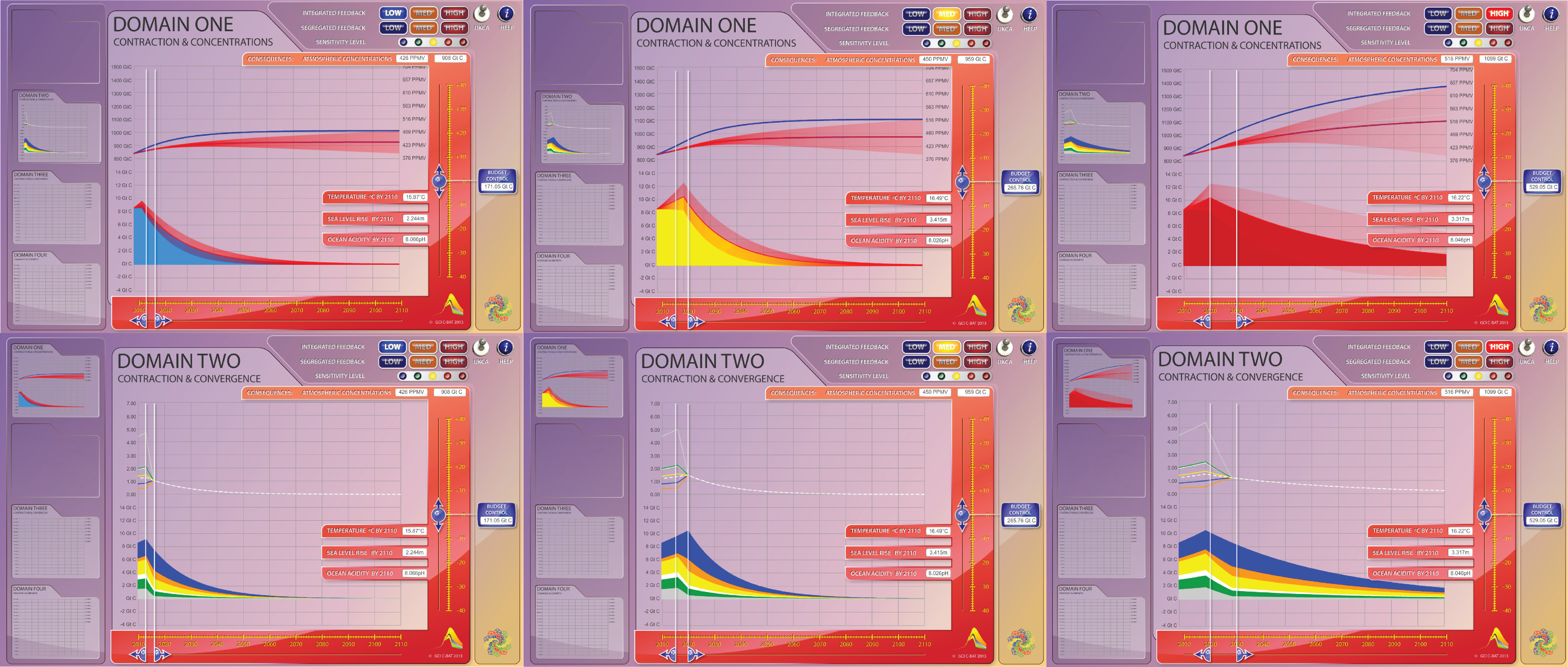 25 April 2014 - "Jupiter finale; spills into the world like an African antelope that falls from the womb, wet but already running."
25 April 2014 - "Jupiter finale; spills into the world like an African antelope that falls from the womb, wet but already running."Woody Allen said that Mozart's Jupiter Symphony was proof of the existence of God.
This beautiful book Orfeo by Richard Powers said this . . . .
Three movements of Mozart’s Symphony 41 pass by: destiny and noble sacrifice, nostalgia for a a vanished innocence, and a minuet so elegant it bore the bejeezus out of him.
And then the finale, its four modest notes. Do, re, fa, mi: half a jumbled scale. Too simple to be called invented. But the thing spills out into the world like one of those African antelopes that fall from the womb, still wet with afterbirth, but already running.
24 April 2014 - "Climate negotiations foundered on burden-sharing, GCI introduced C&C." Any Way You Slice It, Stan Cox
Most estimates of the size of the reduction needed in human ecological impacts focus on greenhouse gas emissions, because the numbers necessary for making such calculations are readily available. One third of Earth’s human population creates 90% of greenhouse gas emissions. International climate negotiations have repeatedly broken down over the question of how to share the burden of emissions reductions among rich and poor countries.In the 1990’s, the Global Commons Institute (GCI) introduced the ‘Contraction and Convergence’ model, under which global emissions would contract dramatically while per capita emissions of rich and poor countries would converge at the global average. In practice this would mean deep reductions in the global North and modest increases in much of the South. GCI’s current figures project that, in order to achieve the required degree of Contraction and Convergence, The North’s emissions should be 80% below today’s level by sometime between 2020 and 2050.
Any Way You Slice It: The Past, Present, and Future of Rationing By Stan Cox24 April 2014 - "A happy medium that is globally viable: contraction & convergence." Eco-Villages Karen T Litfin
In our economically polarized world, where the average per capita income is roughly $7000 but extremes of overconsumption and
destitution persist, the down-to-earth prosperity of eco-villages demonstrates the possibility of a happy medium that is globally viable.A few forward-thinking economists have laid out the process for getting there: contraction and convergence.
In other words down-sizing the global rich and sustainable upsizing for the poor, converging on a sustainable middle-way.
Ecovillages: Lessons for Sustainable Community
Karen T. Litfin
24 April 2014 - The rate at which renewables need to deploy [Contraction & Conversion] is much faster than has been realized.23 April 2014 - 'A New World is Being Birthed'. Day of the Earth, from the well-focused web-site at Pasadena Greensward Civitas.Testing but inspirational writing on 'Radical Hope' at Greensward Civitas
"Even as the world seems to be careening towards self-destruction, it's possible for its people to calmly stand against the unfolding events and consciously choose a different path towards life. The strength and resiliency needed to do this is immense, but humanity has prevailed before in spite of terrible odds."
In all the writing is woven around: -
- Jeffrey Newman's 'Hannay Ahrendt, Radical Evil, Radical Hope' articlein the Berghan Journal,
- the work of the Ecological Sequestration Trust and
- this remarkable and heartfelt movie from UNIFY sub-titled 'A New World is Being Birthed'.
21 April 2014 - HANSEN PLOS Budgets now in CBAT: - Peak 2020 reduce @ 6%; Peak 2020 reduce @ 2%; Peak 2030 reduce @ 6%.
- 1045 Gt Carbon Budget ['C' - 2010-2100] Peak 2050 reduced @ 6%/year
[The Highest Budget in the PLOS paper - this has not been put in CBAT; its approaching RCP 6 & on course for > + 5 degrees]
- 558 Gt Carbon Budget 'B' - [2010-2100] Peak 2030 reduced @ 6%/year
[HIGH Budget in this CBAT run]
- 697 Gt Carbon Budget ['Aa' - 2010-2100] Peak 2030 reduced @ 2%/year
[MEDIUM Budget in CBAT in this CBAT run] [This is the position Hansen advocated in China in Feb 2014]
- 349 Gt Carbon Budget ['A' - 2010-2100] Peak 2020 reduced @ 6%/year
[LOW Budget in CBAT in this CBAT run] [This is the position Hansen adovates for the US in his case in the Court of Appeal in May 2014]
- 171 Gt Carbon Budget ['Aaa' - 2010-2100] Peak 2020 reduced @ 45%/year
Clearly the airborne fractions of these budgets are small.
In other words Hansen is assuming a very strong sink-function of: -
- well under 50% of emissions retained in the atmosphere and
- well over 50% of emissions returned to the sinks.
20 April 2014 - Analysis shows Contraction:Concentration Budget Path-Integrals [HANSEN 'PLOS'] are clearly inaccurate.
Assessing ‘‘Dangerous Climate Change’’: Required Reduction of Carbon Emissions to Protect Young People, Future Generations and Nature
James Hansen1*, Pushker Kharecha1,2, Makiko Sato1, Valerie Masson-Delmotte3, Frank Ackerman4, David J. Beerling5, Paul J. Hearty6, Ove Hoegh-Guldberg7, Shi-Ling Hsu8, Camille Parmesan9,10, Johan Rockstrom11, Eelco J. Rohling12,13, Jeffrey Sachs1, Pete Smith14, Konrad Steffen15, Lise Van Susteren16, Karina von Schuckmann17, James C. Zachos18This is the Hansen 'PLOS' paper in which Hansen produces this image [below - Figure 5] on page 8.
NOTE peaking in 2020, 2030 and 2050 he draws concentration curves reducing as a result of global emissions reductions at: -
- 6%/year 2020 [the position he advocates in this paper] 2030, 2050 and . . .
- 2%/year 2020 [the postion he advocated to the Chinese Government in February 2014 - see slide 32]
Positive Feedback Effects s are obviously omitted from these scenarios as all four concentration curves
[1] 2020 6%/yr, [2] 2020 2%/year, [3] 2030 6%/year, [4] 2050 6%/years 2060
decline pro rata from dates specifed. This is obvioulsly significant error as feedback emissions will increasingly occur as temperature rises.In other words it is obviously erroneous to assume that carbon sinks will act just efficiently whatever the delay in emissions cuts specifed.
Figure 5. Atmospheric CO2 if fossil fuel emissions reduced.
(A) 6% or 2% annual cut begins in 2013 and 100 GtC reforestation drawdown occurs in 2031–2080,
(B) effect of delaying onset of emission reduction.~~~~~~~~~~~~~~~~~~~~~~~~~~~~~~~~~~~~~~~~~~~~~
Below is a GCI image focusing on concentration paths for the period 2000 - 2100.
It extrapolates emissions budgets based on the the text given in the paper.Four Carbon-Budgets 2010 - 2100 extrapolated from the Hansen ‘PLOS’ Paper behind his Appeal Court Case. These theoretically return to 350 ppmv ‘Concentrations’ at rates shown [‘PLOS’ image above is faintly visible in the background of the image below].
Clearly feedback-missions are omitted & airborne fractions are small:to AF 50%. Neither ‘Carbon-Budgets’ A [349 GtC] nor Aa [697 Gt C] are near the 171 Gt C [Aaa] his modeller Pushker Kharecha indicated for Budget A.
- 1045 Gt Carbon Budget ['C' - 2010-2100] Peak 2050 reduced @ 6%/year
- 558 Gt Carbon Budget 'B' - [2010-2100] Peak 2030 reduced @ 6%/year
- 697 Gt Carbon Budget ['Aa' - 2010-2100] Peak 2030 reduced @ 2%/year
- 349 Gt Carbon Budget ['A' - 2010-2100] Peak 2020 reduced @ 6%/year
- 171 Gt Carbon Budget ['Aaa' - 2010-2100] Peak 2020 reduced @ 45%/year
19 April 2014 - "C&C - scientifically literate, normative." Reforming Law & Economy for a Sustainable Earth Anderson Routledge
This is not necessarily to say that emissions trading cannot be effective. When situated within a more scientifically literate, normative policy framework such as ‘Contraction and Convergence’, which prioritises – in order – precaution, equity and efficiency, emissions trading may help accelerate the contraction of greenhouse gas emissions (Meyer 2000: 11, 18-20).
However, because this framework involves (pre)allocation of emissions entitlements on a equal per capita basis and subjects them to sustained contraction over time (on precautionary grounds), it offers no support for the argument that economic growth may serve environmental ends (see also Wiener 2009: 519-21; Feasta 2006: 5-8).
For elaboration of the ‘Contraction and Convergence’ policy framework for per capita equity-based contraction, see its originator, Meyer (2007, 2000 and www.gci.org.uk) as well as Page (2007b: 13-14) and Singer (2004: 35); see also Attfield on effecting a similar outcome by concurrent recognition of the atmospheric commons as part of the ‘common heritage of humankind’ (2003: 169-73).
Meyer, A. 2000. Contraction and Convergence: the Global Solution to Climate Change. Dartington: Green Books.
Meyer, A. 2007. ‘The Case for Contraction and Convergence’ in Cromwell, D. and M. Levene (eds.) Surviving Climate Change: The Struggle to Avert Global Catastrophe. London: Pluto.
16 April 2014 - JAMES HANSEN & the "Young People's Day in Court"My view is that Jim Hansen's important 'appeal' will fail, due to significant self-contradiction.
Seems to me he needs to review this as a matter of some urgency as the hearing is very soon.As it is really a matter of the greatest importance, I hope Jim H doesn't fail. I don't want him to fail, I want him to succeed.
However, with things as they are, I don't see how he can and if he fails, an important opportunity will have been lost.If he disputes column 2 in the image below, I hope he will see the need to: -
- spell out what the integral [carbon-budget weight] of,"global emissions peak 2020 & decline at 2%/yr thereafter"
that he specified to in China in February actually is, if it isn't the 678 Gt C spelled out here;
- explain why the Chinese should now believe in and accept the 171 Gt C global budget he has now [April]
again insisted is what he has argued throughout;
- justify to all the countries who will have to share it, how the US & CHINA alone can consume more than than that global budget
of 171 Gt C between them, requireing the Rest of the World [RoW] to go into negative emissions if it is to be observed.~~~~~~~~~~~~~~~~~~~~~~~~~~~
~~~~~~~~~~~~~~~~~~~~~~~~~~~
JAMES HANSEN & the "Young People's Day in Court"
James Hansen is going to US Court of Appeals in May 2014 to appeal a judgement given against him last year.
He wants the court overturn that judgement & also rule in favour of his 6%/year emissions reduction demand to the US GOVERNMENT.
However, the court seems likely to be confused and therefore unlikely to support the appeal,
as it unclear what Hansen is really asking for in the light of what he has said on this matter this year - as follows: -
- before CHINA - the stresses that appeal to the court case is based on the PLOS paper
calling for -6%/year emissions control globally [giving a 171 Gt C Budget]:
- in CHINA [February 2014] - he told the CHINESE GOVERNMENT emissions must peak in 2020
and then reduce at -2%/year [see his slides slide 32 - giving a 678 Gt C Budget]:
- after CHINA - he insisted to asenior US Acadmic that he said no such thing in CHINA,
and he insisted that the PLOS paper was his absolute and unchanged demand for a 171 Gt C Budget:
- and the implication that for the US & CHINA to consume more than the PLOS global budget between them,
the Rest of the World [ROW] would need to go negative to keep to a 171 Gt Carbon Budget [Row 2 Column 3 in the graphic].NOTE - In a 'draft op-ed' after CHINA Hansen recorded this view: -
- "We scientists should have made clearer that there is a limited “carbon budget” for the world,
i.e. a limit on the amount of fossil fuels that could be burned without assuring disastrous future consequences.
- We should have made clear that diffuse renewables cannot satisfy energy needs of countries such as China and India.
- It seems we failed to make that clear enough. The United States, as the leader in nuclear R&D,
had an opportunity not only to help find a carbon-free path for itself, but also to aid countries such as China and India.
- Indeed, such aid was an obligation. The United States had already used its share of the “carbon budget”
and was beginning to eat into China’s."As Hansen's statements collectively further obscure, rather that clarify this issue, clarification would require the court to decide these crucial issues: -
- what weight of global carbon budget is being considered
- what method for internationally sharing this is being considered
- thus providing a basis upon which to determine, 'who is eating into who's budget'
It would be very helpful if they would do that.
Unresolved for the last 20 years, this fundametally important issue - of shringking and sharing the global carbon budget - has remained hotly contested throughout.
It is of the greatest importance to now resolve this. As things stand the case put before the court by James Hansen summarise like this
11 April 2014 - "C&C - a way of resolving the political and moral problem." Future Risk; Chartered Institute of Insurers
There is a moral and political issue associated with demanding that certain countries reduce emissions just at a time when they are trying to catch-up with more advanced economies. One potential way of resolving this is to adopt a policy of “contraction and convergence”. Under this framework, developing countries would be allowed to grow emissions while developed countries contract theirs until the figures converge. For a discussion of this see Meyer and Crichton (Jan 2005) “Weathering the Storm”, article for Post Magazine, and CII Report (2009) “Coping with Climate Change”
Future risk: Climate change and energy security – global challenges and implications
11 April 2014 - IPCC AR5 RCP Scenarios now in CBAT08 April 2014 - "Climate protection scenarios assume C&C." Desert Power 2050 Klepper et al Kiel University
The scenarios with climate protection are based on the assumption that a contraction and convergence strategy is followed which is intended to reduce greenhouse gas emissions and limit climate change to roughly 2 degrees by the end of this century. For the climate protection scenarios we assume a global reduction of carbon dioxide emissions by 30 percent relative to 1990 levels until 2050. Emissions will start to fall by 2015 and will continue in a linear fashion until 2050. Thus, the decarbonized scenario assesses the investment program of “Desert Power 2050” under the assumption that all regions support the MENA countries to finance their investment costs and there is no electricity trade. All this happens in the contraction and convergence scenario, i.e. fossil fuel prices rise considerably in order to limit CO2 emissions. The trade scenario includes the electricity trade between MENA and Europe and the financial support for MENA investments as in the EUMENA financing scenario, but again in a world of global climate policy.The contraction and convergence strategy (Meyer 2000) consists of reducing overall emissions of greenhouse gases to a safe level (contraction) where the global emissions are reduced because every country brings emissions per capita to a level which is equal for all countries (convergence). 10 All policy scenarios are evaluated by comparing them to a reference scenario. Here we use two reference scenarios. The “current policy scenario” represents a business as usual situation where only current policies are taken into account for future economic trends. The economic development behind the current policy scenario is set to be in accordance with OECD projections. The “climate policy scenario” includes in addition the contraction and convergence strategy as a climate policy. Thus it represents a world with climate protection but without Dii’s renewable energy investment plans.
Desert Power 2050: Regional and sectoral impacts of renewable electricity production in Europe, the Middle East and North Africa
Kiel Working Paper No. 1891 January 2014 * Alvaro Calzadilla, Manfred Wiebelt, Julian Blohmke and Gernot Klepper08 April 2014 - "C&C is the over-arching requirement of global justice." Tim Hayward Just World Institute University of Edinburgh
I develop the normative argument that the basic claim on sufficient ecological space does imply a goal of equality in a sense that is important to recognize under the given circumstances of global justice. The circumstances that constitute the core global challenge today, those that make global justice as such necessary, are that we inhabit a crowded planet. These are circumstances in which humanity, globally, faces a dual problem. One aspect of this is the aggregate overuse of renewable natural resources and environmental capacities that can be referred to as global ecological overshoot. The other aspect consists of the extreme and structurally embedded discrepancies between the life chances of people and peoples in the world that can be referred to as extensive radical inequality (Nagel 1977; Pogge 2002). Whatever else global justice might require, it requires steps to resolve those problems. Such steps can be characterized, in general terms, as requiring both contraction and convergence compared to the current situation of excessive command and occupation of ecological space by some at the expense of adequate access for use by others. Contraction and convergence is thus the overarching requirement of global justice. The goal of convergence in particular, suggests an ultimate goal of equality. The core of the argument for equality of ecological space can be stated quite simply: everyone is entitled to enough (as affirmation of the basic right asserts); fulfilment of this entitlement takes priority over any other distributive principle (as the status of a basic right implies); therefore no one is entitled to more than enough (at least until everyone has enough); meanwhile, as long as everyone is entitled to enough and no one is entitled to more than enough, it follows (at least pro tanto) that everyone is entitled to equal.
Equality and Ecological Space Tim Hayward
March 2014 JWI Working Paper No. 2014/02
08 April 2014 - "The genocidal campaign of Climate Change Contrarians" Dr Robert Nadeau, George Mason UniversityCrimes Against Humanity: The Genocidal Campaign of the Climate Change Contrarians.
Full Article
There are two definitions of crimes against humanity in international law that could apply to the campaign of the climate change contrarians. The first is “grave offences that are part of a widespread and systematic attack against a civilian population,” and the second is “inhumane acts intentionally causing great suffering, or serious injury to body or to mental or physical harm.” (Brown, 2013) -There is no doubt that the Big Lies told by the contrarians about climate science constitute a “widespread and systematic attack against” all of humanity. There is also no doubt that the contrarians were fully aware that they were misleading people in ways that could eventually result in “great suffering, or serious injury to body or to mental and physical harm.” It is not possible for a variety of reasons to charge the Koch brothers and the other contrarians in their vast network with crimes against humanity in the International Criminal Court at The Hague. But we could at least begin to call them by a name that is more appropriate for those who have committed crimes against humanity.The dictionary definition of a contrarian is a person who takes an opposing view. This implies that a climate change contrarian has a view of climate change that is opposed to and could be as valid as other views. My candidate for a more accurate and appropriate definition of climate change contrarian is as follows: “One who lies about the science of climate change and imperils the human future to protect and enhance his or her financial interests and has no regard for the principles of democracy or the welfare or will of the people of the United States.” But since this definition is too long to routinely use in descriptions of the activities of the contrarians, a better idea might be to add the word genocidal in all future references to their campaign. Hence the new name would be the “genocidal campaign of the climate change contrarians.”
Full article
03 April 2014 - "Convergence of per capita emissions the only basis." Rachel Ward Salzman, Yale Human Rights & Development"The world's atmosphere belongs equally to everyone if it belongs to anyone at all ..... "
"One proposal for establishing a more just climate scheme is to replace Kyoto's tentative distributive commitments with a policy mechanism that recognizes the right to emit as belonging equally to each human being" - an idea that has been termed "equal per capita allocation". Although, unsurprisingly, no politician in the United States or Europe has taken seriously the idea of allocating emissions rights on a per capita basis, the Indian government in particular has been particularly outspoken about supporting this approach. Prime Minister Manmohan Singh, in his June 2008 speech on the release of India's first Climate Change Action Plan, declared that
"every citizen of this planet must have an equal share of the planetary atmospheric space. Long term convergence of per capita emissions is, therefore, the only equitable basis for a global compact on climate change."
Allocation of emissions rights, under this view, should cease to reflect the economic muscle of the wealthiest nation states, and should instead be conducted on a worldwide per capita basis."
Yale Human Rights and Development Journal Volume 13, 18 February 2014
Issue 1 Yale Human Rights and Development Journal Article 5
Distributing Emissions Rights in the Global Order:
The Case for Equal Per Capita Allocation
Rachel Ward Salzman
03 April 2014 - "We apply C&C as an initial reference." Uncertainty in an emissions-constrained world. Jonas et al Springer
We apply a “contraction & convergence” approach as an initial reference approach (GCI 2012). This allows establishment of global linear target paths for 1990–2050 (from 36.8 Pg CO2-eq in 1990 to 25.9 Pg CO2-eq in 2050) and for 2000–2050 (from 39.5 Pg CO2-eq in 2000 to 20.5 Pg CO2-eq in 2050), and derivation of global emission targets for 2050.
Uncertainty in an emissions-constrained world
Matthias Jonas & Gregg Marland & Volker Krey & Fabian Wagner & Zbigniew Nahorski
Climatic Change, Springer, February 2014
03 April 2014 - A beautiful story of music in Kinshasa, told & shown in the Guardian by Aisha Gani & Andrew McConnell"I found Josephine and the rest of the Orchestre Symphonique Kimbanguiste inspirational. They all come from poor backgrounds, but are passionate about their music. When they performed, the hairs on the back of my neck stood up. I think the shot speaks to the power of music to lift us up.
But it also speaks to the power of women and the human spirit, which is something indestructible and full of hope. It was just a magical moment, one of those times when you wonder if you'll ever see something as beautiful again."
02 April 2014 - "Day of Reckoning." Laurie Barlow, Greensward Civitas, Pasadena California, responds to IPCC AR5 WG2Day of Reckoning Laurie Barlow
This last December, a definitive paper was published by James Hansen and his colleagues that effectively shows why carbon emissions must stop immediately in order to prevent catastrophic climate change, and that most likely even one degree of change in the global temperature is not safe, let alone the two degree change currently on the table for discussion by the UNFCCC for a climate agreement.
A review in a recent article of the urgency of the situation emerging from scientific study is sobering. The diagram developed in this article is based upon information published in Science magazine showing an assembled curve known as "the wheelchair", which is a temperature chart that tracks the historic carbon levels precisely. It's documented with lots of other science measurements in a Climate Change summary and update pagebeing maintained by Guy McPherson.
In order to show the essence of the situation that we're in, and anticipating the decision that the world will need to come to in December of 2015 in Paris, I've appended the diagram to lay out the kind of future that we'll be effectively deciding on, just to clarify the issue. As you can see, human civilization emerged and flourished over 10,000 years during a time of very benign conditions consisting of a balanced ecosystem with abundant plant and animal life. This ecosystem was fairly self-regulating in that the carbon was balanced by living systems. That mechanism is nearly gone now, having been decimated by human habitation. We are now creating a new mass extinction, wiping out countless species. On top of that, the carbon spike we've created is pulling a massive trigger, and the system now has a minimal capacity to balance and is beginning to wobble. The Climate Change Institute at the University of Maine is now tracking these climate anomalies on a daily basis.
This spike in carbon that shows on the chart is unprecedented - its rate of increase is faster than anything in the total record of geological history. Before humanity existed, the carbon and temperature had periods where these conditions existed, but these changes ocurred over thousands of years, not in the extreme spike of the 200 years of our industrial age. The atmospheric carbon was absorbed and trapped by the ecosystem which ultimately balanced out after the last ice age.
The astronomically rapid release of heat and carbon by human activities, which this planet has never seen before except during extinction events(there have been five) is triggering catastrophic climate anomalies that are destabilizing a very weakened ecosystem that no longer has any reserve capacity to absorb the shock.
The IPCC's AR5 fifth assesssment report, Part 2, has just been released, and their consensus is that we're experiencing an already dangerous impact on the global climate. A summary of the high points is here. A video from this report - Working Group II - Climate Change 2014: Impacts, Adaptation, and Vulnerability, goes into further depth on their perspective.
The responsibility for a solution lies ahead of us in Paris next year, and it simply consists of an equitable global agreement on emissions by all countries that rapidly cuts back on all fossil fuel use. As a strategy, all countries need to enact policies and laws that will enable them to arrive simultaneously at the agreed-on goal of zero emissions. Large and rich energy consumers will need to curb their energy use faster than the poorer countries. The poorer countries will not be asked initially to make large sacrifices but must agree that they will strive to reach zero carbon emissions at the same time as everyone else. Rich nations will assist them so they do not have to sacrifice their social or environmental goals but poor countries need to understand that they will be held accountable and not exempt from the unified global effort. Without this concerted global effort the strategy will fail, and there won't be much left to do about it.
02 April 2014 - "C&C - an important principle; ethical, logical, practical." Evolution's Edge, Graeme Taylor
The question of economic justice is central to resolving major global issues and creating a sustainable global system. The poorest four fifths of the world's population will never agree to any arrangement that leaves them with less than their fair share of the Earth’s resources. And yet no meaningful change is possible without their agreement - although the Chinese produce less pollution per person than Americans, their huge population means that China now emits more green house gases each year that the United States.
This problem can be solved using a principle called Contraction and Convergence (C&C). C&C means that developed nations should reduce their emissions while allowing developing nations to increase their emissions until all nations are emitting the same per capita levels of greenhouse gases. Sir Nicholas Stern proposes that average global emissions need to be reduced from their present levels of about 7.7 tons (seven tonnes) per person per year to around 2.2 tons (two tonnes) per person. This would mean that Australia and the US, which produce about 22 tons (20 tonnes) of pollution per head each year, will need to make reductions of 90%; while a developing nation like India, which now produces almost 2.2 tonnes of greenhouse gases per person, will have to prevent its per capita emissions from rising.
While C&C is an important principle and one that developing nations are likely to agree to, it is only part of the solution. The challenge is not just to negotiate a fairer way for continuing to pollute and increase global warming but to negotiate agreements that stop further pollution and begin to reduce global warming. Erwin Jackson, Policy Director of the Australian Climate Institute, said that Sir Nicholas’ targets were dangerously conservative. “What he’s saying is that it is OK to get on a plane if there’s a 50% chance it will crash. The kind of stabilization targets he ... talk[s] about would only give us a 50·50 chance of avoiding dangerous climate change." The only solution that is both ethical and sustainable is for every person on the planet to be assigned the right to their fair ecological footprint (their Earthshare).
Any person who consumed and polluted more than their fair share of resources would have to purchase extra resources from other individuals who were consuming less than their share. There are multiple benefits to this approach. It is ethical, logical and practical; it creates a market mechanism for creating a sustainable global economy; it rewards conservation rather than consumption and it provides a simple system for redistributing resources fairly and eliminating the worst poverty on the planet.
Of course, no nation is likely to agree to reduce their consumption of resources and production of waste if this will necessitate a reduction in living standards. It will only be possible to secure international agreement when people can see that their economic security will be improved by the creation of a fair and sustainable global economy. A paradigm shift will need to occur for the nations of the world to change their destructive environmental habits: most people will have to recognize that further economic growth is only possible if it takes place within environmentally sustainable limits; and most people will have to realize that the fastest growing sectors of the economy are those that are reducing their use of increasingly scarce and expensive resources.
.
Follow @aubreygci Tweet
UNFCCC C&C Submission - Support for Submission
